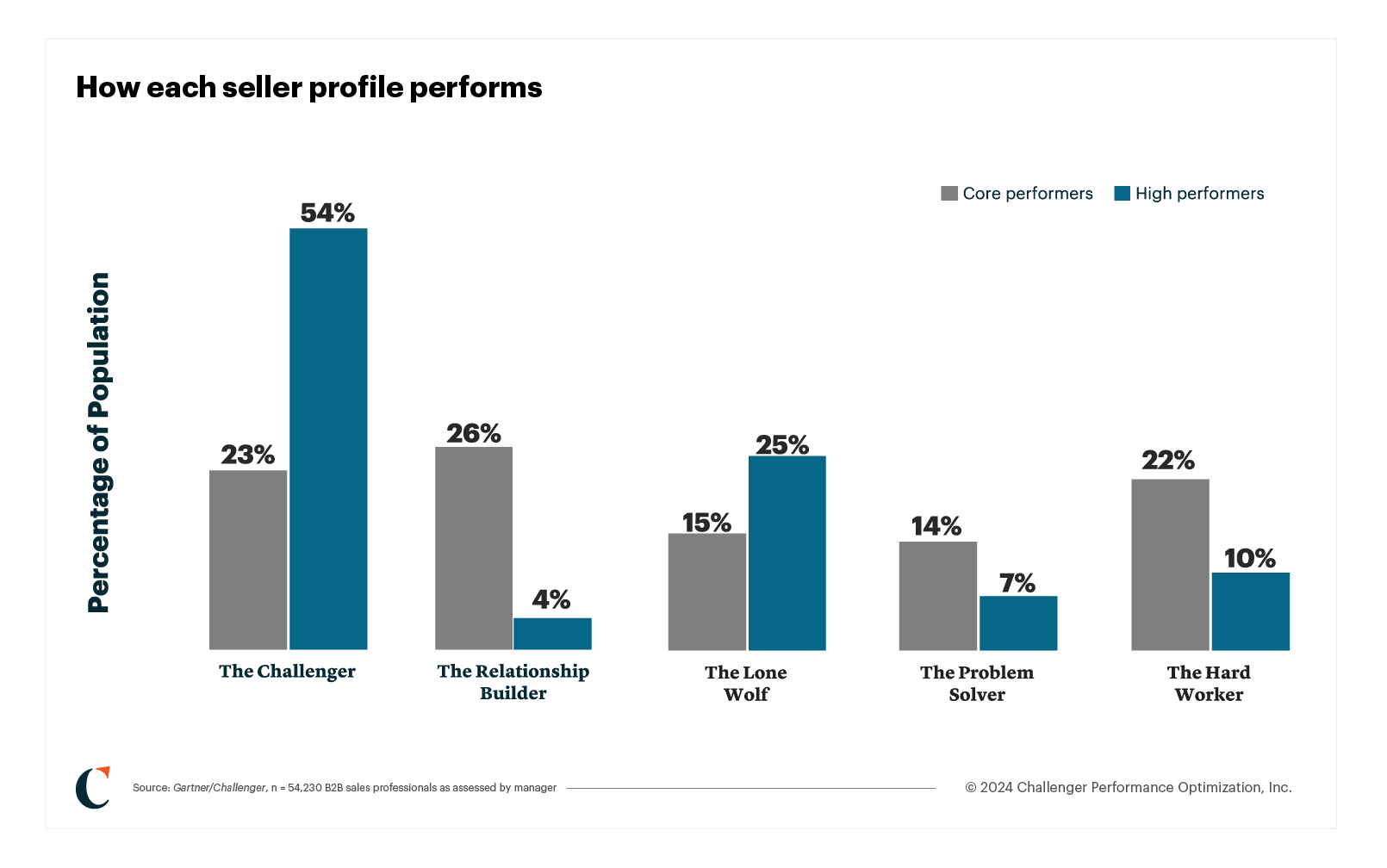Though sales trends may change, sales leaders’ goals remain fundamentally similar: grow pipeline, close deals, increase revenue. Perhaps that’s why sales methodology training remains important to so many organizations, even as the buying-selling landscape continues to change. According to Gong’s 2024 State of Revenue Leadership report, 79% of the highest-paid revenue leaders rolled out a new sales methodology in the previous year. Though we haven’t tracked those leaders down (yet), we can anticipate one challenge based on our long years of experience: reluctant sellers who refuse, for one reason or another, to embrace a new way of selling.
Rolling out a new methodology and ensuring adoption represent two completely different issues, but to meet their goals, sales leaders must bridge the gap. That means getting those recalcitrant sellers on board by overcoming their objections and making it easier for them to embrace change and learn.
Five Challenger Selling Profiles
To get sellers on board, you must know where they are now and where you want them to go. When you imagine a reluctant seller, a very specific personality type likely springs to mind. But what makes a successful seller – and what behaviors do they exhibit?
The original Challenger research, published in “The Challenger Sale,” began with a study from CEB (now Gartner) that revealed the sales experience as the biggest driver of customer loyalty. This unexpected finding led authors Matt Dixon and Brent Adamson to ask what makes a good seller. After asking thousands of sales managers to identify the top 20% of their sales force as measured by performance against goal, they used the results to sort reps into five profiles. Core performers came from every category, but star performers came from one dominant category: the Challenger.
Of all the high performers in the study, nearly 40% were Challengers. Meanwhile, Relationship Builders generated the fewest star performers.

The Problem Solver (14%)
This seller lives to solve customer problems, even after the deal closes. This is more important to them than finding new business, to the detriment of their own performance. The smallest number of reps, about 14%, fall into this category.
The Lone Wolf (18%)
This seller is self-assured and confident in their instincts. Sales managers know them well because they rarely update their CRM, typically skip trainings, and generally resist any guidance or coaching. They hit their quota, and in return, managers tolerate their behavior. About 18% of sellers fall into this category.
The Hard Worker (21%)
This seller always goes the extra mile. They’re the first to come into the office and the last to leave. The Hard Worker doesn’t give up easily, is self-motivated, and seeks out feedback for personal development. It’s easy to love Hard Workers — and that’s one reason their performance in complex sales is so disappointing. About one-fifth (21%) of sellers fall into this category.
The Relationship Builder (21%)
Customers ask for this seller by name. They build strong advocates in their customer’s organizations, give generously of their time, and get along well with everyone. Another 21% of sellers fall into this category.
The Challenger (27%)
Challengers stand out because they see the world differently. They understand their customer’s business and build growth opportunities around specific commercial insights. The Challenger relishes debate and isn’t afraid to push customers. 27% of sellers fall into this category.
Those results beg the question: are sellers stuck with their natural profile type?
Absolutely not. No matter where sellers fall, they CAN learn to augment their natural selling style with Challenger skills. But they must be willing to learn. If sellers are reluctant to change, they’re either missing the skill, lacking the will, or unwilling to summit the hill (meaning they haven’t bought into the concept yet).
Hear more of this concept from Alex Panou on our most recent Winning The Challenger Sale webinar, “How to Train the (Seemingly) Untrainable).”
Now, let’s dive into three types of reluctant sellers and how to get them on board.
Non-Sellers
This group of potential sellers hail from a host of different backgrounds and emphatically do not “do sales.” Perhaps they absorbed business development duties from a colleague and don’t know how to sell (i.e., they lack the skill). We also see this type of objections from those that transition into sales from different roles. Think of the engineer or analyst whose manager says “you’d be great at sales,” before they roll their eyes. This person lacks the will to sell. Or, maybe this type of potential seller simply isn’t bought into the value of challenging customers; consider the client success manager who focuses on customer satisfaction and fears that challenging customers during an upsell process may sacrifice the relationships they see as paramount.
For this group, we can aid adoption by overcoming objections. Use these approaches:
- Challenger isn’t just for sales. Challenger, at its heart, means disrupting a customer’s status quo. There are applications beyond sales, including marketing, customer service, or even personal interactions.
- Customers want to be challenged. Over a decade of research into B2B buying behavior shows that Buyers value sellers who introduce new ideas or approaches to solving business problems far more than they value friendly relationships.
- Share examples. Engineers like evidence; show them examples of people like them succeeding.
- Create a safe environment to practice. No one likes to get it wrong — so give them opportunities to fail and learn without risking any business.
The Unwilling
This second group of sellers may voice fears about not having the right to challenge customers, whether out of concern that it will change the dynamics of a longstanding relationship, a lack of confidence in their own materials or research, or something else. This group also includes those who are deeply devoted to their own selling styles and skeptical of the need to adopt something new.
For these sellers, embracing change means overcoming fear. There’s the fear of failing, letting clients down, or changing, perhaps late in a successful career. For these sellers, the pain of staying the same must be greater than the pain of change. It may take more time to convince them that challenging helps.
- Everyone makes mistakes. Even experienced sellers and highly-successful clients don’t get it right 100% of the time. It’s okay if you don’t either, as long as you keep trying.
- Buying and selling have changed. Buying has become more complex, with stakeholders, sales cycles, and other factors growing in complexity. If a Lone Wolf wants to be successful, they must change too — what they’ve always done won’t work anymore.
- Be part of the Insight engine. Explain the importance of Reframing customers and helping them understand why they need to change. That type of exposure will get them even more comfortable not just with challenging, but understanding why change matters.
It may also help to give this group a simple way to test out the Challenger approach. The framework we refer to as “A Gap B” offers a simple, accessible formula to help customers move from their current state to a new way of doing business– essentially, challenging their thinking with an undiscovered problem.

Sellers with cultural concerns
Finally, some sellers may block adoption out of a conviction that Challenger methodology is a bad fit for their culture — or their clients. They worry they’ll upset clients by being too assertive, that relationships are too important for them to openly question customers, or that Challenger selling only works in America.
To help increase adoption among this group, try this approach:
- Emphasize that Challenger works in every region. As Veronica Coli addressed in “Beyond Borders: Myths About Challenger in International Markets,” Challenger can be adapted to work in any region. In fact, of the organizations who partnered with us to implement Challenger methodology in their sales organizations, over 40% come from outside of the US.
- The strongest relationships share trust. Building that trust sometimes means honestly delivering bad news or engaging in a debate.
- Pay close attention to the dial of Constructive Tension. You need some tension to move any conversation forward. Make sure your use of Constructive Tension doesn’t go too far, particularly in certain cultures.
- Reiterate why you challenge clients. Our research shows time and again that buyers want sellers who can be trusted advisors who help them think about their business problems in a new way, identify and minimize risk, and improve their business.
Challengers aren’t born — they’re made
Your sellers are smart and capable. And if they’re like most people, they don’t love change — which includes adopting a new methodology, especially if it feels unlike them. But Challenger isn’t a fad – it’s built on research that shows the sales experience is the biggest driver of customer loyalty. More than that, it relies on the demonstrated success of a particular type of seller. Sellers may have an inherent selling style, but their future isn’t set in stone if they’re willing to adapt and learn.
To get the most reluctant sellers over the hump, sales leaders must bust the myth that “the customer is always right.” Further, they must adopt a Challenger mindset themselves: driving growth among individual sellers – no matter their age or background – is possible if their coaches and managers are willing to make them uncomfortable. In short, there’s no such thing as an “untrainable” seller – just reluctant people in need of a mindset shift.
Challenger, Inc.
Challenger is the global leader in training, technology, and consulting to win today’s complex sale. Our sales transformation and training programs are supported by ongoing research and backed by our best-selling books, The Challenger Sale, The Challenger Customer, and The Effortless Experience.
More from our blog
Stop pitching AI. Start teaching it: The Challenger Way
Key takeaways Most AI deals stall because buyers don’t know how to buy, not because of product limitations. Traditional feature-based pitches…
Sales Transformation: How to Build Predictable Growth
What Is Sales Transformation? Sales transformation is more than a new process or technology—it’s a fundamental shift in how organizations sell, lead,…
Strengthen Your Coaching Skills with Challenger’s PAUSE Framework
There’s only one seller productivity investment endorsed as more important than all others by Matt Dixon and Brent Adamson, authors of “The…
What are you waiting for?
Transform your sales team.
The best companies grow, and grow fast, by challenging customers, not by serving them.




